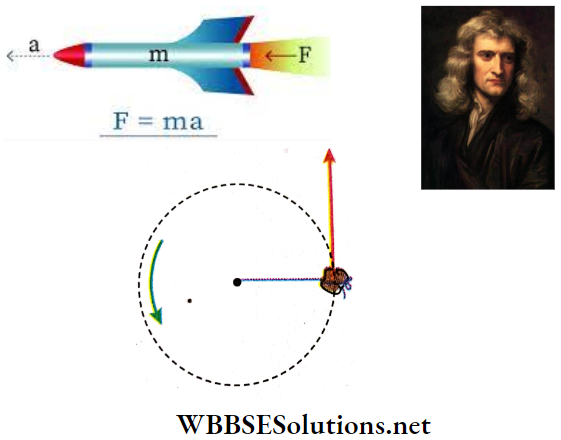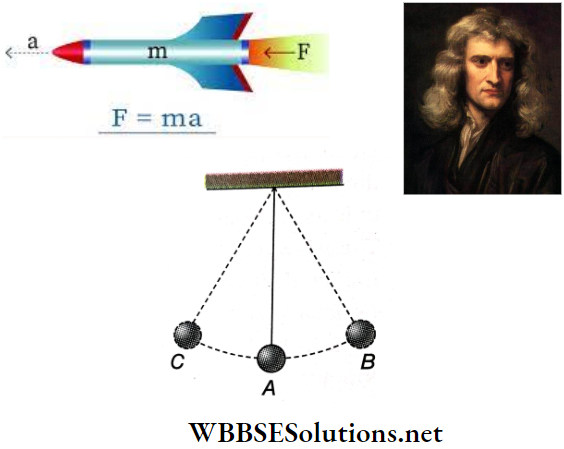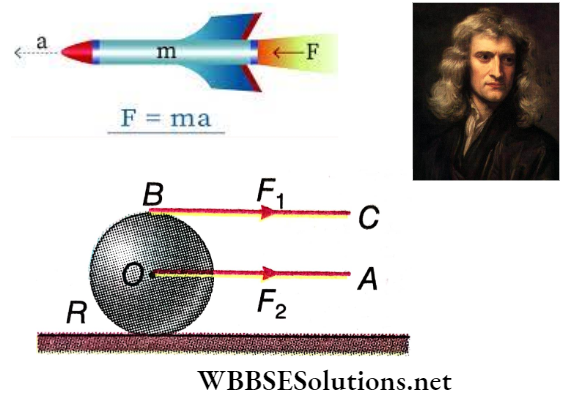Newton Law Of Motion – Discussions On The First Law
From the first law, we come to know about
- The inertia of a body and
- Definition of force.
Inertia Of A Body: The first law leads to the idea that the natural tendency of a body at rest, is to remain at rest; or, the natural tendency of a moving body is to continue to be in its state of uniform motion.
In both cases, the body cannot change its state by itself. The natural tendency of a body to resist any change in its state of rest or of motion is called the inertia of the body.
Inertia Of A Body Definition: The property of a body that enables it to continue in its state of rest or of uniform motion is called inertia. Inertia can be either
Read and Learn More: Class 11 Physics Notes
- The inertia of rest or
- Inertia of motion.
The Inertia Of Rest: The tendency of a stationary body to remain at rest forever, is called the inertia of rest.
A Few Examples Of Inertia Of Rest:
- When a vehicle suddenly starts moving, a passenger sitting or standing inside it leans backward. The passenger’s body was at rest when the vehicle was at rest.
- But when the vehicle starts moving, the feet being in contact with the vehicle are set into motion. However, the upper part of the body tries to maintain its state of rest and hence moves in the direction opposite to the direction of motion of the vehicle.
- From a vertical stack of books, if any book from the middle is rapidly pulled out, the remaining books of the stack do not topple over due to inertia.
- If we make a pile of carrom pieces and hit the bottom piece hard enough with a striker, it will move away, but the rest of the pile will remain at the original position.
- The lowest piece moves because of the force exerted by the striker on it. However, the rest of the pile remains at its place due to the inertia of rest.
- When a tree is vigorously shaken, the branches of the tree are in motion but the leaves tend to continue in their state of rest due to inertia of rest. As a result, leaves get separated from the branches of the tree and fall down.
Experimental Demonstration Of Inertia Of Rest: A postcard is kept on top of a glass. A coin is placed on the postcard, just above the mouth of the glass. When the postcard is given a sudden horizontal flick of a finger, it flies off sideways and the coin, due to its inertia of rest, drops into the glass.

Inertia Of Motion: The tendency of a moving body to maintain its motion in a straight line at a constant velocity is called inertia of motion.
A Few Examples Of Inertia Of Motion:
- When a moving vehicle suddenly applies brakes, passengers lean forward or fall. They were in motion with the vehicle; but when it suddenly decelerated, their lower limbs being in contact with the vehicle slowed down, but the upper parts of their bodies continued to move forward.
- The blades of an electrical fan continue to rotate for some time due to its inertia of motion even after the fan is switched off. Blades slow down and finally stop because of air resistance and other damping forces.
- A bicycle continues its motion, even after the cyclist ceases pedaling.
- Athletes run some distance before taking a long jump. The inertia of motion helps them to cover a longer distance.
- A stone, tied to the end of a string, is rotated in a circular path. If the string snaps suddenly, due to inertia of motion the stone flies off tangentially with the velocity at that instant.
- Since, the direction of velocity in a circular motion, at any point, is along the tangent at that point, the stone follows that tangential path.
- For a simple pendulum, the lowest position of the bob at A is the equilibrium position. When the bob is taken to B and released, the earth’s pull makes the bob move toward A.
- Due to the inertia of motion it does not stop at A, and continues up to C. Again, due to the pull of the earth it starts moving towards A. Thus, the pendulum oscillates about its mean position till air resistance brings it to rest.


Experimental Demonstration Of Inertia Of Motion: A heavy metallic sphere A is placed on a plank B fitted with wheels. The ball and the plank together, are set in motion. If the plank stops colliding with obstruction C, sphere A, due to its inertia of motion, cannot stop and topples across obstruction C.

Force: Newton’s first law of motion states that the state of rest or of uniform motion of a body cannot be altered without the application of a force. In certain cases, there exists opposing forces like friction.
Then, the applied force should be greater than the opposing forces to bring about a change in the state of motion of the body. For example, a heavy boulder cannot be moved, or a moving train cannot be stopped by the force applied by a single man. This discussion leads to the definition of force.
Force Definition: Force is an external influence that changes or tends to change the state of rest or of uniform motion of a body.
Force Is A Vector Quantity: It has both magnitude and direction. In addition, the line of action of the force is also important. For example, we consider the sphere R on a horizontal floor having its center at O. Let force F1 along BC or force F2 along OA, act on R. While the force F2 will cause a rectilinear motion of R, F1 will set up a rotation.

Inertial And Non-Inertial Frames Of Reference: When the motion of a body is considered on or near the surface of the earth, the earth’s surface is taken as the fixed frame of reference.
- A stone lying on the surface of the earth remains in that state of rest unless an external force is applied to it. Also, a spherical object, lying on the floor of a train moving with a uniform velocity, remains at rest in the absence of an external force.
- Hence, for a frame of reference, stationary or in uniform motion, Newton’s first law of motion holds good. Such stationary or uniformly moving frames are called inertial frames of reference. In an inertial frame of reference, all three laws of Newton are valid.
On the other hand, suppose the train, with the spherical object on its floor, accelerates suddenly. The object will also move with acceleration but in the direction opposite to that of the train. Though no external force is applied to the spherical object, it will change its state of rest.
- Hence, the first law of motion is not applicable in a train moving with acceleration. A frame of reference undergoing acceleration is called a non-inertial frame of reference. Newton’s laws of motion are not applicable in non-inertial frames of reference.
- The fact that acceleration is produced even in the absence of an external force in a non-inertial frame of reference, can be explained by considering a fictitious or pseudo force.
- It implies that in a non-inertial frame when any real external force is absent, a fictitious force changes the object’s state of rest or of uniform motion. Centrifugal force, in circular motion, is one of the most common pseudo forces, encountered in our daily lives.
In context, it may be mentioned that the force-acceleration relation, i.e., F = ma may be applicable even in a non-inerial frame of reference if the pseudo forces are properly taken into account.

